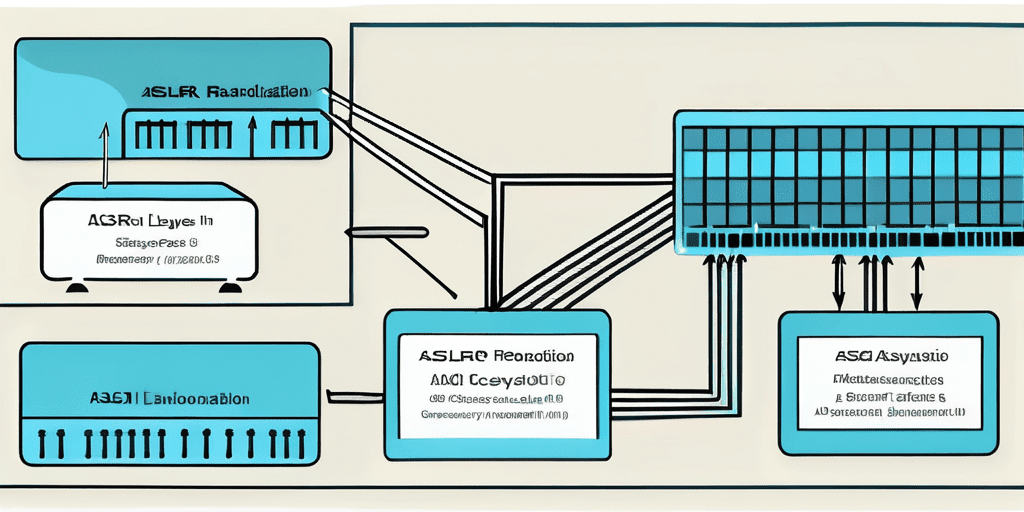Updated November 18, 2024
In cybersecurity, one of the most prevalent threats organizations face is the danger of buffer overflow attacks. These dangerous exploits exploit a program’s memory vulnerabilities to overwrite data and execute malicious code. Security measures like Address Space Layout Randomization (ASLR) have been developed to combat this. This article will delve into the intricacies of ASLR and buffer overflow attacks, exploring how they work and their impact on cybersecurity.
Introduction to ASLR and Buffer Overflow Attacks

Address Space Layout Randomization (ASLR) is a security measure implemented in modern operating systems to protect against exploits that rely on predicting the location of key data structures or executable code within a program’s memory.
ASLR works by randomizing the memory addresses where different program components are loaded. This makes it extremely difficult for an attacker to determine the exact location of critical elements, such as function pointers or return addresses, which are often targeted in buffer overflow attacks.
But how exactly does ASLR randomize the memory addresses? The operating system achieves this by introducing unpredictability during the loading process. Each time a program is executed, the operating system assigns random memory addresses to its various components, such as the stack, heap, and libraries. This makes it challenging for an attacker to exploit a specific memory address, as it will differ each time the program is run.
Imagine a scenario where a program is designed to accept user input and store it in a buffer. If the program does not adequately validate the input size, an attacker can send a large amount of data that exceeds the buffer’s capacity. This excess data spills into adjacent memory addresses, corrupting the program’s execution flow.
Once the attacker gains control of the program’s execution flow, they can manipulate it to their advantage. This could involve executing arbitrary code, escalating privileges, or even launching further attacks on the system.
Buffer overflow attacks have been a persistent problem in software development and continue to pose a significant threat to computer system security. That’s why cybersecurity professionals must understand how they work and the countermeasures in place, such as ASLR.
The Role of ASLR in Cybersecurity

How ASLR Works
ASLR operates by randomizing the memory addresses where key program components, such as libraries and data structures, are loaded. By introducing this randomness, ASLR creates a moving target, making it significantly more challenging for attackers to exploit memory vulnerabilities.
Benefits of ASLR
The implementation of ASLR provides several benefits in terms of enhancing cybersecurity. For starters, it increases the difficulty of predicting memory addresses, hampering the success rate of buffer overflow attacks. Additionally, ASLR significantly lowers the probability of an attacker successfully executing arbitrary code by thwarting their ability to exploit memory vulnerabilities.
Another advantage of ASLR is its ability to mitigate the impact of zero-day vulnerabilities. Zero-day vulnerabilities refer to software vulnerabilities that are unknown to the software vendor and, therefore, unpatched. These vulnerabilities pose a significant threat as attackers can exploit them before a patch is released. However, with ASLR in place, even if a zero-day vulnerability is discovered, the randomization of memory addresses makes it much harder for an attacker to exploit it effectively.
ASLR also plays a crucial role in preventing information leaks. By randomizing memory addresses, ASLR makes it difficult for attackers to locate specific data structures or libraries in memory. This reduces the risk of exposure of sensitive information, such as encryption keys or user credentials, during an attack. The added layer of protection provided by ASLR enhances a system’s overall security posture.
The Mechanics of Buffer Overflow Attacks
Understanding the Process of Buffer Overflow Attacks
Buffer overflow attacks typically occur when an attacker sends more data to a buffer than it can accommodate, causing the excess to overflow into adjacent memory areas. By carefully crafting their input, attackers can overwrite critical data and inject malicious code that can be executed by the targeted program.
Potential Consequences of Buffer Overflow Attacks
Successful buffer overflow attacks can have devastating consequences. Attackers can gain unauthorized access to systems, compromise sensitive data, and even gain control over an entire network. Such exploits can potentially cause significant financial and reputational damage to targeted organizations.
When a buffer overflow occurs, the attacker takes advantage of a vulnerability in the targeted program’s memory management system. By sending excessive data, the attacker forces the program to store the overflow in adjacent memory areas often reserved for other purposes.
Once the attacker overflows the buffer, they can overwrite critical data in the adjacent memory areas. This can include important variables, function pointers, or even the return address of a function. By manipulating these values, the attacker can redirect the program’s execution flow to their malicious code.
It’s important to note that buffer overflow attacks can be particularly dangerous because they can bypass security measures such as ASLR. ASLR randomizes the memory layout of a program, making it harder for attackers to predict the location of critical data. However, skilled attackers can still find ways to exploit buffer overflow vulnerabilities and execute their malicious code.
The consequences of successful buffer overflow attacks are far-reaching. Attackers can gain unauthorized access to systems, allowing them to steal sensitive information, modify data, or even disrupt critical services. In some cases, attackers can use buffer overflow attacks to gain control over an entire network, compromising multiple systems and causing widespread damage.
Organizations that fall victim to buffer overflow attacks can face severe financial and reputational consequences. The costs associated with recovering from such attacks can be substantial, including expenses related to incident response, system restoration, and legal actions. Additionally, the loss of customer trust and damage to the organization’s reputation can have long-lasting effects.
ASLR and Buffer Overflow Attacks: The Connection
How ASLR Prevents Buffer Overflow Attacks
ASLR prevents buffer overflow attacks by introducing randomness into the memory layout of a program. By shuffling the positions of key components, ASLR thwarts an attacker’s ability to predict and manipulate memory addresses, making it exceedingly difficult to exploit buffer overflow vulnerabilities.
Limitations of ASLR in Preventing Buffer Overflow Attacks
While ASLR is an effective mitigation technique, it is not foolproof. Sophisticated attackers can employ techniques like information leaks or brute-force approaches to bypass ASLR and successfully exploit buffer overflow vulnerabilities. In such cases, additional security measures are necessary.
One information leak technique attackers may use is heap spraying. This technique involves repeatedly allocating and filling the heap with carefully crafted data, increasing the chances of finding a predictable memory address. By combining heap spraying with other attack vectors, such as JavaScript vulnerabilities, an attacker can bypass ASLR and successfully execute a buffer overflow attack.
Another limitation of ASLR is its reliance on the operating system’s random number generator (RNG). If the RNG is not truly random or if an attacker can somehow predict the randomization seed, they may be able to determine the memory layout and bypass ASLR. To mitigate this risk, ensuring that the RNG used by the operating system is robust and properly implemented is crucial.
In addition to ASLR, other security measures can be implemented to enhance the protection against buffer overflow attacks further. For example, stack canaries can detect buffer overflows by placing a random value before the return address on the stack. If this value is modified during a buffer overflow, an error can be triggered, preventing the successful execution of the attack.
Code reviews and rigorous testing can help identify and fix potential buffer overflow vulnerabilities before they can be exploited. Organizations can significantly reduce the risk of buffer overflow attacks by adopting a proactive approach to software development.
Advanced Techniques in Buffer Overflow and ASLR
Bypassing ASLR: Techniques and Challenges
Attackers continuously innovate and refine their approaches to bypass ASLR. One technique that has gained prominence is the return-to-libc attack. This technique redirects the program’s execution flow to existing code libraries, bypassing ASLR’s randomization of memory addresses. Another technique, heap spraying, involves strategically allocating large amounts of data in the heap, increasing the chances of finding a predictable memory address to exploit.
However, these techniques pose their challenges. Return-to-libc attacks require a deep understanding of the target program’s memory layout and the ability to identify suitable functions within existing libraries. On the other hand, heap spraying requires careful manipulation of memory allocations and deallocations, often requiring a significant amount of trial and error.
Mitigating Buffer Overflow Attacks: Strategies and Tools
Organizations must adopt a multi-layered security approach to mitigate the risk of buffer overflow attacks. Secure coding practices play a crucial role in preventing buffer overflow vulnerabilities from being introduced. Developers can significantly reduce the attack surface by following best practices such as input validation, bounds checking, and proper memory management.
In addition to secure coding practices, conducting regular vulnerability assessments is essential. These assessments help identify potential buffer overflow vulnerabilities and allow organizations to prioritize remediation efforts. Employing runtime protection tools, such as stack canaries and non-executable memory, can also help detect and prevent buffer overflow attacks in real-time.
Combining these strategies and tools can help organizations create a robust defense against buffer overflow attacks. However, no single solution can guarantee complete protection. Ongoing monitoring, incident response planning, and continuous improvement of security measures are essential to staying one step ahead of attackers.
Conclusion
Understanding ASLR and buffer overflow attacks is crucial for organizations aiming to ensure robust cybersecurity. ASLR plays a pivotal role in safeguarding against buffer overflow attacks by adding an essential layer of randomness to memory layouts. By comprehending the mechanics of these attacks and employing appropriate mitigation strategies, organizations can minimize the risk posed by this ever-present threat.
As you’ve learned, the complexities of ASLR and buffer overflow attacks require sophisticated defense strategies to protect your organization’s digital assets. Blue Goat Cyber specializes in providing top-tier B2B cybersecurity services, including penetration testing and compliance with HIPAA, FDA, SOC 2, and PCI standards. Our veteran-owned business is dedicated to securing your operations, with particular expertise in medical device cybersecurity. Don’t leave your cybersecurity to chance. Contact us today for cybersecurity help and partner with a team as committed to your security as you are.
